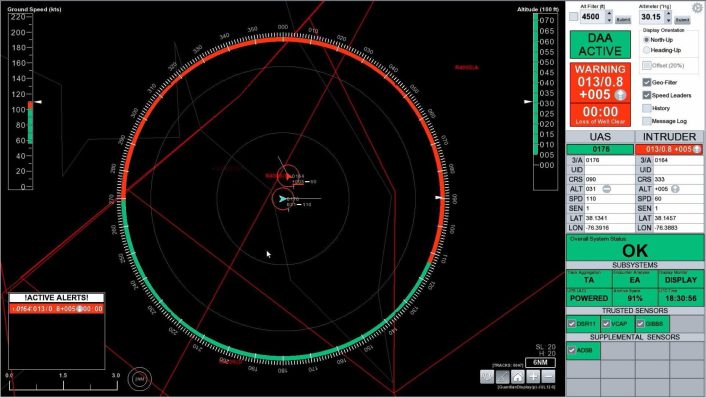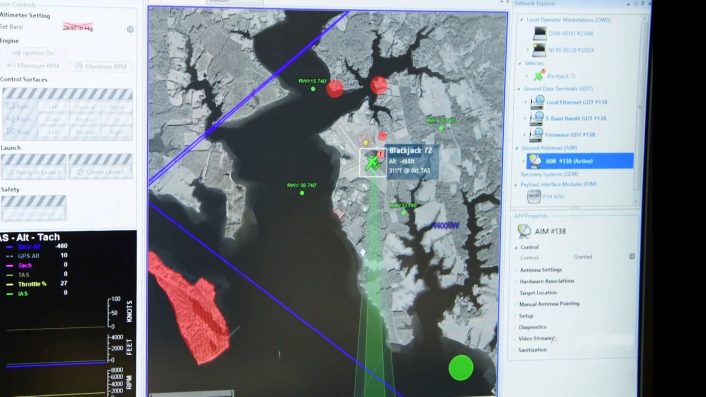Using the Detect and Avoid System, the MQ-9B operated in U.S. airspace like any other piloted aircraft, without the need for the special handling usually required for UAS.
The U.S. Navy’s Naval Air Warfare Center Aircraft Division (NAWCAD) announced on Sep. 17, 2025, the flight of a MQ-9B SeaGuardian from California to Washington, during which the drone “operated in U.S. airspace like a piloted aircraft for the first time using its advanced onboard detect and avoid system.”
NAWCAD did not identify the system used or mention when the flight took place. It had however previously revealed work on the Guardian ground-based software that uses existing ground sensors to alert the RPA’s ground operator about proximity with other manned or unmanned aircraft.
Prior to that, in a Sep. 4, press release, GA-ASI said it had deployed an ASW (Anti-Submarine Warfare)-configured MQ-9B SeaGuardian from Palmdale to Naval Air Station Whidbey Island (NASWI) in Washington to support the Open House planned there on Aug. 23, suggesting that it was when the test took place. Both NAWCAD and GA-ASI also used the same image in their announcements.
GA-ASI said: “Utilizing its advanced onboard Detect and Avoid System, the MQ-9B was able to launch from its flight facility near Palmdale, California, and fly to Whidbey Island without the normal special handling required for UAS. Effectively, it was able to operate in the national airspace like any other piloted aircraft.”
Was the Guardian software used?
NAWCAD said the Guardian software allows unmanned aircraft “to operate more freely and safely” in manned civilian, and eliminates “older methods that required closing off airspace or using chase planes.”
It is not clear whether this means the MQ-9B was operated by the Guardian software or its derivative in its human-in-the-loop remote operation. However, the mention of closing off airspace implies that the aircraft flew without the dedicated flight corridor usually mandated by the FAA, although it is unclear if the UAS shared the route with other piloted aircraft.
At the request of NASWI leadership, GA-ASI’s MQ-9B SeaGuardian® was on display in an anti-submarine warfare configuration, giving public and military attendees an up-close look at the largest and most capable multi-mission Group 5 #UAS.
Read the news: https://t.co/C2GHllYbwr pic.twitter.com/j1PWuxJPPt
— General Atomics Aeronautical Systems, Inc (GA-ASI) (@GenAtomics_ASI) September 4, 2025
GA-ASI then also mentioned its continuing partnership with NAWCAD’s AIRWorks division, for multiple ASW, ISR and Targeting demonstrations. “NAWCAD AIRWorks is also the Lead Systems Integrator and Program Manager for the Navy Operational Evaluation of MQ-9B in 2026,” GA-ASI added.
Both NAWCAD’s post on Facebook and GA-ASI’s release explicitly described the detection and avoidance technology on the MQ-9B as “onboard,” while the Guardian has clearly been described as a ground-based system. However, the explanation could be that Guardian is the ground extension of the onboard Detect and Avoid System.
In fact, NAWCAD explains that Guardian detects nearby aircraft and alerts the operators, and uses multiple approved sensors to track aircraft in real time. The Guardian software could collect the data from the Detect and Avoid System’s sensors and then relay them to the ground station.
Origins
Guardian was developed following an FAA requirement mandating safer proximity flight operations of unmanned aircraft alongside both civilian and military manned aircraft. In 2023, NAWCAD was also targeting to adopt it on the MQ-8 Fire Scout, MQ-4C Triton, and future Small Tactical UASs.
Cleared by NAVAIR, the software is now awaiting FAA approval. NAWCAD also mentioned the Guardian being used on the MQ-9s at NAS Pax River, MQ-25 Stingray, the RQ-23 Tigershark, and the Reapers at MCAS (Marine Corps Air Station) Cherry Point. The MQ-25 Stingray unmanned aerial refueler is expected to fly off the U.S. Navy carriers by late 2025 or 2026.
Guardian ground-based collision avoidance software
In an Aug. 8, 2022, press release about the first test of the Guardian by the Unmanned Air Test and Evaluation Squadron 24 (UX 24), where it flew two RQ-21 Blackjack drones, NAWCAD said the system makes “manned/unmanned teaming safer.”
Guardian “improves airspace safety” by tracking “manned and unmanned systems […] within a 200 nautical mile radius […] using ground-based sensors to communicate with air vehicle operators in ground control stations,” NAWCAD said. It provides “visual cues for navigation and traffic avoidance maneuvers like turn, ascend, or descend in instances where collisions are imminent – all on a computer screen, similar to GPS in a car.”

An algorithm displays it in a “traffic light” – red, yellow, green codes – on the ground station console. This allows the unmanned system to “navigate freely in a controlled airspace” like the NAS Pax River facility, a February 2023 video feature by NAWCAD said. The goal is for the unmanned systems to “fly just like regular aircraft,” and “integrate the UAV into the traffic pattern” at NAS Pax River, and possibly other airspaces “more efficiently,” the background narration added.
FAA restrictions made scheduling of flight operations “increasingly difficult,” just as “unmanned aviation became a larger part of the Navy’s portfolio,” the August 2022 NAWCAD press release mentioned. Only a single unmanned vehicle could operate over NAWCAD’s airspace, the Atlantic Test Ranges, at any given time. This complicated flight testing for Pax River’s six squadrons testing every aircraft for the Navy and Marine Corps.
Sensors and collision avoidance
In the August 2022 press release about the Jul. 28 tests of the two RQ-21 Blackjacks, NAWCAD said: “Guardian alerted its operator of an imminent collision once the two systems came within 400 feet of each other and made avoidance maneuver suggestions.”

A table at the bottom listed the “Trusted Sensors” DSR11, VCAP, GIBBS and the ADS-B as the “Supplemental Sensors,” showing they were ‘activated’. We recently reported about an Apr. 8, 2025, close call between a KC-135R Stratotanker from the 100th Air Refuelling Wing based at RAF Mildenhall and a Jonker JS-1 glider, because of the latter’s ADS-B being turned off. The UK also recently certified the Protector RG1 unmanned aircraft to safely fly it in non-segregated airspace.
“Looking ahead, we’ll put Guardian through complex tests to confirm it will reliably handle congestion in the busiest airspaces as we work toward FAA certification which could significantly reduce Stingray’s developmental test time and costs,” Dulude said in the August 2022 press release. This suggests a reference to the latest test with the MQ-9B SeaGuardian.
Manned-Unmanned Teaming
The fact that GA-ASI’s MQ-9B SeaGuardian was used for a scaled up, complex test of the Guardian, means the system could be trialled onto the MQ-20 Avenger and/or the XQ-67A OBSS. The company previously said drones validate sensing and autonomous flight technology for the Air Force’s Collaborative Combat Aircraft program, represented by YFQ-42A.
We’re not just talking about innovation — we’re delivering it. YFQ-42A collaborative combat aircraft represents decades of experience and innovation in jet-powered #UCAV technology. And it’s ready today.
Read more: https://t.co/WYx3pr8VKM#FighterFriday #YFQ42A pic.twitter.com/Ehi3ZMUmjA
— General Atomics Aeronautical Systems, Inc (GA-ASI) (@GenAtomics_ASI) September 5, 2025
Melon said in the August 2022 NAWCAD press release that the Guardian would enable safe manned/unmanned teaming. “We’re starting at DOD test ranges, but every squadron or ship could integrate this system seamlessly for a safer air wing at sea or ashore,” he said.
“Our single priority is getting the Guardian ready for the future of Naval and Marine Corps unmanned aviation,” explained Melon. “We’re training our test pilots and fine-tuning the tech during this demo to prepare for the new carrier based unmanned air system, MQ-25’s, arrival at Pax but Stingray is just the beginning.”
The War Zone also reported on Apr. 30, 2025, about U.S. Marine Corps officials saying at the Modern Day Marine exposition how “ensuring future Collaborative Combat Aircraft (CCA) drones can fly in close proximity to friendly crewed aircraft without colliding with each other remains a major challenge.”









